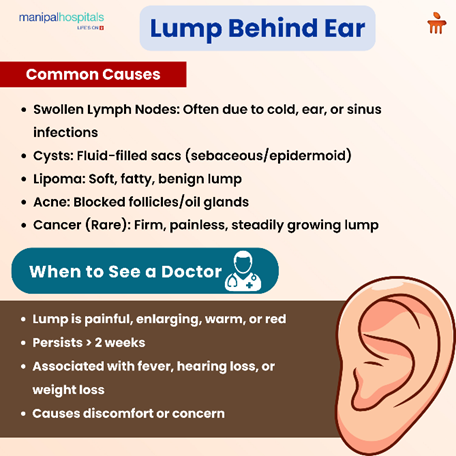
A lump behind the ear is a small swelling or bump that can appear for various reasons. Most of the time, these lumps are not serious, but it’s important to pay attention to them. There can be many reasons for finding a lump behind the ear, which includes infections, cysts, inflamed lymph nodes, and so on. While it may be concerning, most lumps are not dangerous.
However, it is important to keep a tab on whether the lump is enlarging, painful, or firm which might yield clues to the underlying cause. Your healthcare provider can examine the lump and use imaging or labs to suggest next steps. Some lumps start suddenly and then go away on their own, while others stick around. Most causes of lumps behind the ear can be treated, and in most cases they are treatable. Knowing what is going on as soon as possible helps minimise complications, provides proper treatment, and gives you peace of mind to think about the underlying issue early on.
Synopsis
What Causes a Lump Behind the Ear?
Lumps behind the ear may arise for a number of reasons, some more serious than others. One of the most common causes of swelling behind the ear is due to swollen lymph nodes in response to an infection like a cold, ear infections, or sinus infections. Skin issues can also lead to cysts, which are classified as sebaceous cysts or epidermoid cysts. They generally occur behind the ear. Sometimes, a lipoma will occur, which is a fatty, soft growth that is benign. Persistent lumps can be a concern and indicate more severe conditions, potentially a tumour (benign or malignant). Here are these causes in detail:

Swollen Lymph Nodes
Lymph nodes are small, kidney-shaped organs that assist in fighting off infections. If you've ever had a cold, ear infection, or sinus infection, you probably noticed swelling and tenderness in the lymph nodes behind your ear. Typically, they shrink down to normal size once the infection clears. Occasionally, they may remain enlarged for a longer period of time, particularly if the infection was chronic or you have other medical problems going on. Your swollen lymph nodes could also be accompanied by pain, warmth, or redness around them.
Lipoma
A lipoma is a soft, fatty lump that grows under the skin. It’s generally painless, slow-growing, and feels smooth or rubbery to the touch. Lipomas are benign and harmless in the vast majority of cases. They can be found behind the ear and on other parts of the body. Doctors generally will just ignore them unless they become large, uncomfortable, and/or troublesome aesthetically. Depending on the size, surgery is a possible treatment option to remove the lipoma.
Cysts
Cysts are small fluid-filled sacs that can find themselves behind the ear. The common types of cysts are sebaceous or epidermoid cysts, which develop when skin oils or cells become trapped. Cysts can be soft or firm to the touch, and can become red, swollen, and tender when infected. The majority of cysts are harmless and can grow larger over time. A simple drainage of a cyst, or removal, may be performed by a doctor if you want to get rid of the cyst or if you are concerned about comfort, or for cosmetic purposes.
Acne
Acne can form behind the ear as small, red, and/or pus-filled bumps. Though acne is more common on the face, neck, and back, clogged hair follicles or oil glands will also get clogged behind the ear, too. Angry acne lumps can be tender to the touch and can burst if you pick at them. The best management of acne is to keep the area clean, limit the use of oily hair products, and use topical acne medication that you can get at the local pharmacy. If your acne persists despite your best efforts, refer to a dermatologist for an evaluation.
Cancer
Though rare, lumps behind the ear can sometimes be cancerous. They may feel firm, grow steadily, and not hurt initially. Skin cancer, lymphoma, or tumours from adjacent areas can also present with lumps in this location. Other symptoms to consider include changes in the skin over the lump, swelling that does not dissipate, and unexplained loss of weight. If a lump does not shrink or continues to grow, seeking medical care is important, as early detection is critical.
In addition, mastoiditis can also cause lumps behind your ear due to an infection of the mastoid bone. Other inflammatory conditions related to the skin or soft tissue could be triggered as well. Believe it or not, infections of the mouth or scalp can create lymph node swelling or swelling of tissue behind the ear. Most of these types of causes are benign and temporary, so it is important to monitor their size, tenderness, and consistency so they can be evaluated appropriately.
When to See a Doctor
While most lumps that appear behind the ear are generally not harmful, you should arrange to be seen by a medical professional if you notice certain characteristics. You should visit a medical professional if the lump:
-
appears suddenly without a noticeable reason
-
feels very painful, tender, or warm to the touch
-
get larger over time, or doesn't go away
-
makes it red, oozing, or shows other signs of infection
-
is associated with fever, chills, or other unusual symptoms
-
affect hearing, balance, or cause discomfort with daily activities
-
causes you to worry or just feels different than your other lumps
Early evaluation ensures proper treatment and peace of mind.
Diagnosis and Treatment for Lump Behind Ear
When a lump appears behind the ear, a 360 medical evaluation is important to determine the cause and cater appropriate treatment. Below is an overview of the diagnostic process and potential treatments.
Diagnostic Process
The evaluation begins with a detailed patient history and a thorough physical examination, including an inspection of the ear canal. Additional tests may be ordered to identify the underlying cause of the lump.
|
Diagnostic Step |
Description |
|
Medical History |
The doctor gathers information about symptoms, duration, and relevant medical history. |
|
Physical Examination |
A thorough exam, including the ear canal, to assess the lump's characteristics. |
|
Blood Tests |
Tests such as a Complete Blood Count (CBC) to screen for infections or other conditions. Additional tests may include autoimmune or tumour markers. |
|
Imaging Tests |
Ultrasound or CT scan to visualise the lump's structure and location. |
|
Biopsy |
If cancer or abnormal cells are suspected, a biopsy may be performed with patient's consent. |
Prompt evaluation and diagnosis are critical to ensure appropriate treatment and avoid potential complications.
Conclusion
A lump behind the ear can be scary, but most lumps are harmless and treatable. The symptoms can include swollen lymph nodes, cysts, lipomas, acne, or, very rarely, cancer. Keeping track of size, pain, and other symptoms associated can help ensure you receive timely medical care. An evaluation by a healthcare provider in the early stages means you can receive a proper diagnosis and have appropriate treatment or relief of concern. Keeping the ordinary habits of good hygiene, tending to an infection quickly, and monitoring changes without waiting and hoping for clearance can keep similar lumps from recurring. With proper care and awareness, most lumps can resolve themselves without any further harm done, meaning you remain your healthy, active self!
If you notice a lump behind your ear that is painful, persistent, or causing concern, don’t ignore it. Early evaluation can make all the difference. Consult the ENT specialists at Manipal Hospitals for accurate diagnosis and advanced treatment options.
FAQ's
The most common lumps appear to be benign lumps, either infections, cysts or swollen lymph nodes. Only a small portion will lead to cancer or serious problems.
Many lumps, like swollen lymph nodes or bumps related to acne, will disappear within a few days to a few weeks with proper care.
Mild lumps, such as a mild infection or acne bump, may resolve with frequent handwashing, warm compresses, or topical (over-the-counter) treatments. However, lumps that are persistent, painful, or growing should be medically evaluated.
Seek medical attention if the lump grows, becomes painful, persists beyond a couple of weeks, or is accompanied by fever, hearing changes, or other concerning symptoms.
You can reduce the risk by maintaining good hygiene, treating ear and sinus infections promptly, and avoiding excessive use of oily hair or skin products.





















 6 Min Read
6 Min Read
















